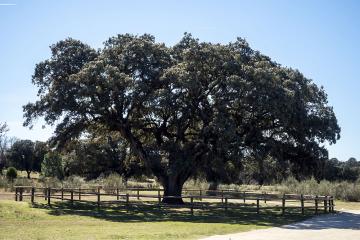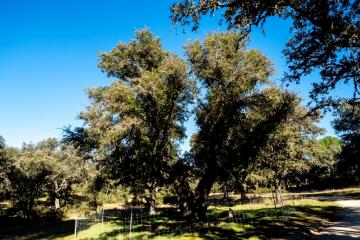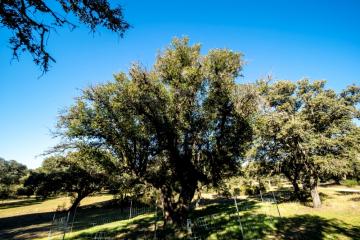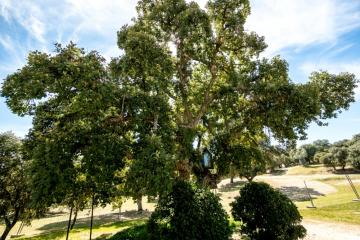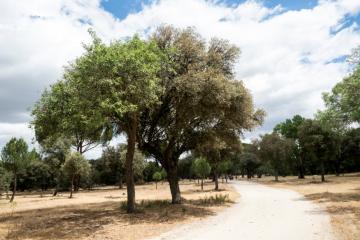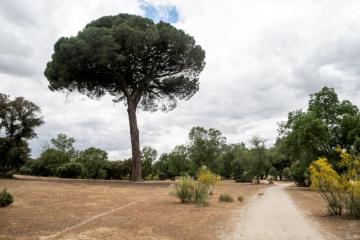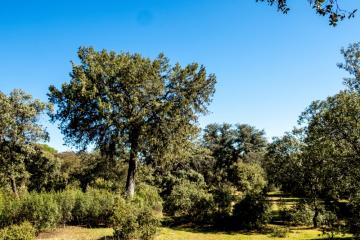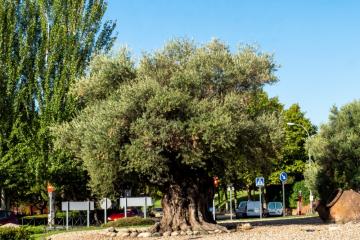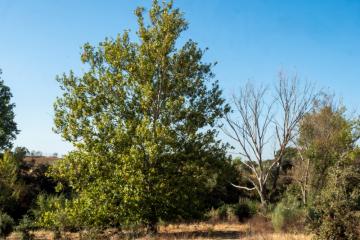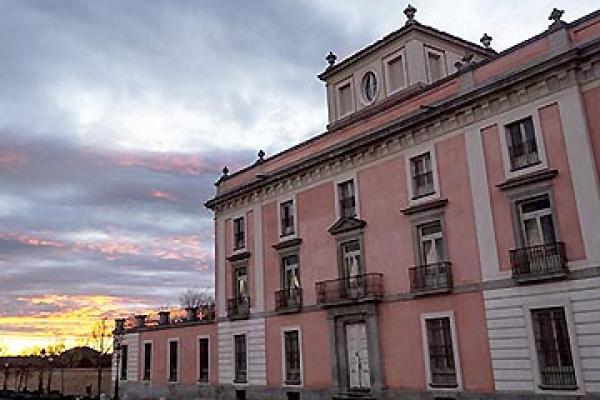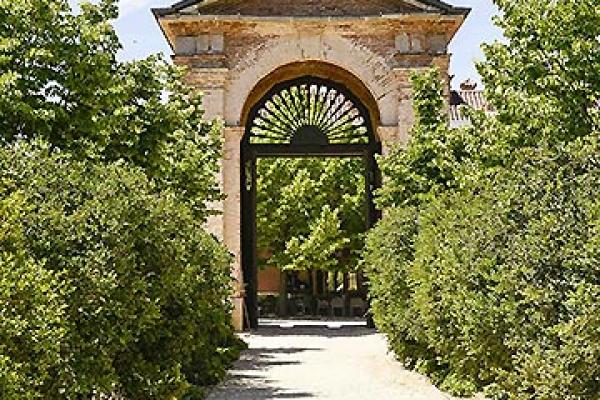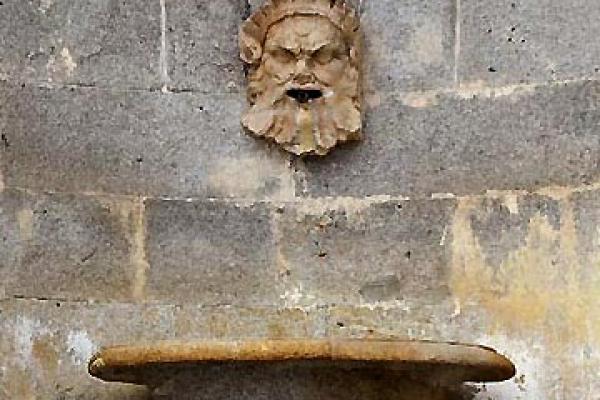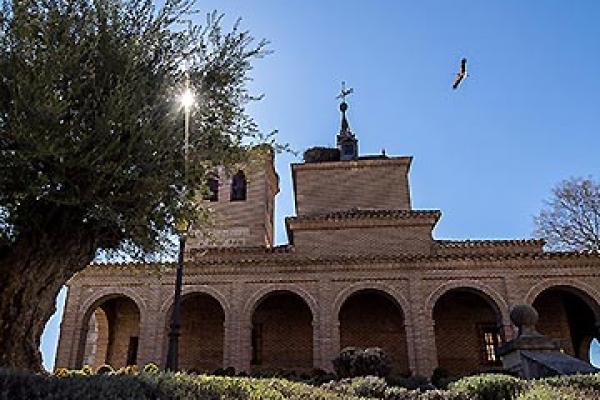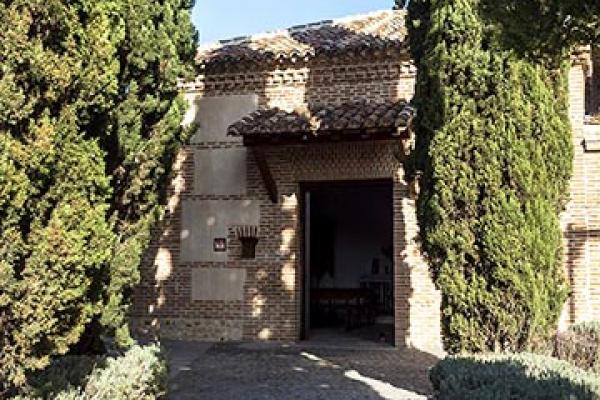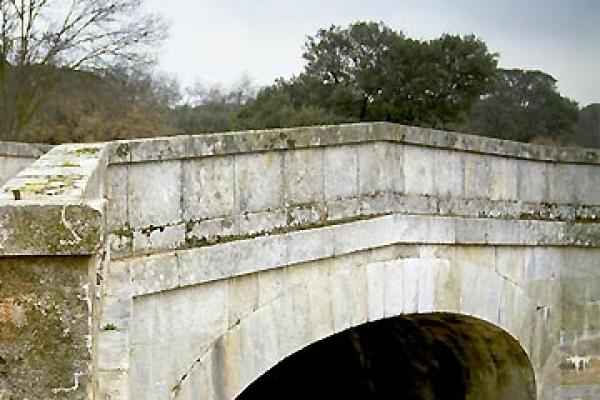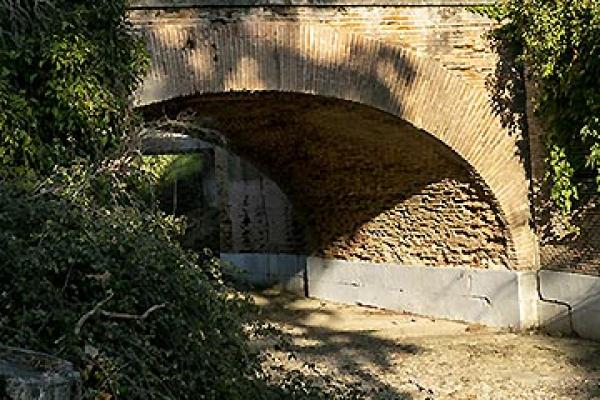Itinerary: The trees are located in the Valle de Valenoso, Monte de Boadilla, and in the urban area.
Highlights: Singularity, Dendrochronology, Urban Trees.
Length: 17 km.
Approximate duration:
- On foot: 6-6.5 h.
- Bicycle: 3.5 h.
Elevation: 655-712 MASL
Average: Grade: 2 - 3%. Maximum: 9%
Accessibility: Trees located in the urban area and near the Arroyo de la Fresneda. The walking route must be completed by section, as access is hampered by the presence of linear infrastructures at some points.
The route of notable trees features those appearing in the Catalogue of Endangered Species and Legacy Trees of the Community of Madrid, and those included in the Inventory of Notable Trees drawn up by the municipality of Boadilla del Monte.
It is a 12-km route on which you will find trees of great beauty and majesty. The Alcornoques de Romanillos, two cork oaks recognised by the Community of Madrid and located in the municipality of Boadilla, are included on Route No. 22 of the Parque Regional del Curso Medio del Río Guadarrama (Regional Park of the Middle Course of the Guadarrama River).
Notable and unique trees are distributed in three areas distant from each other within the municipality: the Monte de Boadilla, the town centre, and the Valle del Arroyo de Valenoso, such that this trail can be divided into three sections:
SECTION 1. Monte de Boadilla
The route begins across from the Aula Medioambiental (Environmental Classroom), heading towards the valley of the Arroyo de la Fresneda. Once you have crossed the bridge over the streambed, you take the main path, very busy with walkers and those enjoying the sports facilities here. Soon you will see the perimeter fence around the oak known as La invencible, declared of interest by the municipality for its age and beauty.
SCIENTIFIC NAME: Quercus ilex.
LOCATION: Camino del Romeral.
APPROXIMATE AGE: 200 years.
DIMENSIONS: 15 metres high, its crown measuring 20 meters across, and a trunk with a 4.1-meter perimeter.
DESCRIPTION: "La Invencible" features a pyramidal trunk that branches off at the four-meter mark into four powerful arms whose lower branches sag from their own weight, almost touching the ground. The pruning work done for its conservation gives it open branches that further enhance its majesty.
Continue the path along the Camino del Romeral to a crossroads, where you take the path that bends to the left, towards the wooden bridge crossing the streambed. After bordering the dog park, the road reaches the Boadilla-Pozuelo highway (M 513) where there was, on the right, a stone pine (Pinus pinea) included in the Community of Madrid's Catalogue of Legacy Trees.
Across from here, at the Finca de la Milagrosa, there stands the Alcornoque de La Milagrosa, classified as a Notable Tree for its beauty, state of conservation, history and popularity in the municipality.
SCIENTIFIC NAME: Quercus suber
LOCATION: Finca La Milagrosa.
APPROXIMATE AGE: 125 years.
DIMENSIONS: This tree's trunk measures 2.1 meters across, while its crown is 10 meters in diameter, matching its height.
DESCRIPTION: The cork oak of La Milagrosa branches into several trunks, and its branches spread irregularly, furnishing its crown with a beautiful structure. Returning to the Camino del Romeral, on the main path, about 60 meters from the duck pond, there stands on one of the first slopes another large stone pine, included on the municipality's Inventory of Notable Trees.
Its crown is easily visible from the town centre.
SCIENTIFIC NAME: Pinus pinea.
LOCATION: Duck pond.
APPROXIMATE AGE: 200 years
DIMENSIONS: The trunk of this stone pine is 3.80 meters across. It stands 25 meters high, its crown having a diameter of 14 meters.
DESCRIPTION: Its rounded crown branches off in the upper third of the trunk, at a great height. It stands alone, though nearby one can find similar trees.
Continue along the route bordering the sports centre and, before crossing the Boadilla-Pozuelo highway, you will come to one of the biggest Portuguese oaks in the Monte de Boadilla, also included on the Inventory of Notable Trees. On the other side of this road stands the Puente de Ventura Rodríguez (bridge), also known as the Puente de Piedra (Stone Bridge), these forming part of Boadilla's historical heritage.
SCIENTIFIC NAME: Quercus faginea.
LOCATION: Boadilla-Pozuelo highway.
APPROXIMATE AGE: 100 years.
DIMENSIONS: The tree stands 13 meters high, its crown spans 14 meters across, and the trunk's perimeter measures 3.50 meters.
DESCRIPTION: Branched trunk at a low height. Its location, very close to the highway, means that it does not go unnoticed, it being particularly prominent in the autumn when its foliage changes colour.
The path extends through the Valle de Pradolargo (valley), along the Camino de los Militares, where the dehesa (wooded pastureland) ecosystem may be observed on the plains near the stream, with holm oak groves on the slopes of the woodland. After about 500 meters, you will come to, on the left of the way, a large Iberian pear tree (Pyrus bourgeanae), a small species associated with holm oak groves resting on acidic soils. In the Monte de Boadilla there are several of them, this one being the biggest.
SCIENTIFIC NAME: Pyrus bourgeanae.
LOCATION: Camino de los Militares.
APPROXIMATE AGE: 60 years
DIMENSIONS: This tree’s trunk has a perimeter of 1.10 m, it stands 10 meters high, and its crown measures 8 meters across.
DESCRIPTION: Its crown is asymmetrical, due to the presence of a holm oak very close to it, which prevents it from developing in a uniform way. It is a tree featuring dramatic seasonal colour changes.
At this point take the first path on the left, rising through a dense holm oak grove and an area of repopulated pine trees until the first crossing, where, on the right, there are two cork oaks (Quercus suber), one of them listed as a Legacy Tree by the Community of Madrid. In addition to the size and age of these trees, their uniqueness lies in the fact that cork oaks are rare in this area of Mediterranean woodlands, as they are typically found in more humid areas. Thus, its distribution in the western Iberian Peninsula reveals the clear impact of humid Atlantic winds.
SCIENTIFIC NAME: Quercus suber.
LOCATION: Valle de la Corchera.
APPRODIMATE AGE: 200 years.
DIMENSIONS: Its crown measures 13 meters across, and it stands 11 meters high. Its arms have a perimeter of 2.4 meters.
DESCRIPTION: This is a branched tree, from the base, with three arms, one of which was cut, the resulting hollow being evident. Near it one finds another tree of the same species, also of great size.
From this singular cork oak, the route continues, turning westward through a less dense oak grove, with the grey-leaved cistus (Cistus albidus) and gum rockrose (Cistus ladanifer) as species accompanying the hiker, along the sun rose,(Halimium halimifolium) until reaching the first path, which turns to the right, and the ascent continues, with mild grades in the direction of the next noteworthy tree. When you reach the Camino del Puente de Piedra you must walk some 60 meters north to find a unique Spanish juniper (Juniperus thurifera), also included in the Community of Madrid's Catalogue of Legacy Trees, for its age, splendour, and rarity.
The Spanish Juniper is a species that is considered relictual, so many of these trees on the Iberian Peninsula are protected, as their numbers have been considerably reduced. It is a species associated with severe climates, great annual thermal oscillation, and altitudes between 800 and 1600 meters.
SCIENTIFIC NAME: Juniperus thurifera.
LOCATION: Valle de los Zorros (Valley of the Foxes).
APPROXIMATE AGE: 200 years.
DIMENSIONS: This tree stands 12 meters high, and its crown measures 10 meters across. The trunk's perimeter is 1.4 meters
DESCRIPTION: It features a clean trunk and an irregular crown that opens up on its upper third, which is rare in the Spanish juniper, generally more pyramidal.
At this point it is time to head back, following the Camino del Puente de Piedra (Stone Bridge) southward. The trail runs parallel to the edge of the Club de las Encinas, to the Carretera de Pozuelo, where it returns along the same path until the beginning of the route, at the Arroyo de la Fresneda.
SECTION 2. City Centre.
As mentioned, the City of Boadilla wishes to document the municipality's arboreal heritage through the publication of a Catalogue of Notable Trees. This inventory includes trees located in the city centre and in the woodland. One of them is the olive tree of the Rotonda de las Tinajas (roundabout) and another is a sweetgum tree on the Calle de los Mártires. To see them you will need to go up from the Aula Medioambiental (Environmental Classroom) on the Calle de los Mártires, where you will find this tree across from the entrance to the Residencia del Pilar. From this point, taking the Calle de Pedro González, you will reach the Rotonda de las Tinajas (roundabout) where the century-old olive tree is located.
SCIENTIFIC NAME: Olea europea.
LOCATION: Rotonda de las Tinajas, on the Boadilla-Majadahonda highway.
APPROXIMATE AGE: 200 years.
DIMENSIONS: A thick and short single trunk with a perimeter of 4.70 m, characteristic of this species. The tree features three arms, and stands 5.40 m.
DESCRIPTION: Planted in the Rotonda de las Tinajas along with two other smaller ones, this is a species of marked symbology, associated with peace and triumph, its branches being the prize given to the winners of the Olympic Games, in Greek civilisation.
SCIENTIFIC NAME: Liquidambar stiraciflua.
LOCATION: Calle de los Mártires, across from the Residencia El Pilar.
APPROXIMATE AGE: 30 years.
DIMENSIONS: This tree stands almost 12 meters high, and its crown measures 10 meters across. The trunk's perimeter is 1.4 meters.
DESCRIPTION: The sweetgum tree is a species of great ornamental value, thanks to the texture of its trunk, the starry shape of its leaves, and its striking autumnal colour change. In the winter its starry fruits hang from its branches, short and of great symmetry. This tree has a perimeter of 1.17 m and stands 11.60 m high.
SECTION 3. Valenoso.
Finally, this route travels along the M513 highway towards Brunete, until the Arroyo de Valenoso, taking the Avenida del Pastel at the last roundabout.
At the intersection of this street with the streambed, very close to the sewage plant, stands this London plane (Platanus x hispanica). Having appeared spontaneously, it presents an unusual shape, as it has not been pruned, which these trees normally are.
It is not the only London plane of these characteristics in Boadilla. On Route 22 of the Parque Regional del Río Guadarrama there stands another large one, near the bridge over the river. Said route also features some sizeable honey locust trees (Gleditsia triacanthos), and the cork oaks that have been called the “alcornoques de Romanillos”, listed as Legacy Trees by the Community of Madrid, as mentioned above.
SCIENTIFIC NAME: Platanus x hispanica.
LOCATION: Valle de Valenoso (valley).
APPROXIMATE AGE: 35 years
DIMENSIONS: Its perimeter is 2.4 m, and it stands 18.6 meters. It is included in the Parque Regional del Curso Medio (middle course) del Río Guadarrama.
DESCRIPTION: Of special note its natural appearance, difficult to find as a species widespread in urban gardening, where pruning prevents one from appreciating its natural forms.
MOST TYPICAL TREE SPECIES FOUND IN THE MONTE OF BOADILLA:
Holm Oak
Scientific Name: Quercus ilex
Common Name: Oak
Family: Fagaceae
Distribution: Mediterranean Zone
Type of soil: The oak is the quintessential species of the Mediterranean ecosystem. It prefers acid sandy soils, but can also grow in basic soils, giving rise to ecosystems with different floristic compositions.
Description: A slow-growing tree with leaves of dark green evergreen on the face, greyish on the underside, with a leathery and jagged edge. Its abundant flowering is provided by its hanging male flowers, yellow in colour. Its fruit is the acorn, and it is a species that does bears fruit irregularly from year to year.
Curiosities: Wood from the oak is hard and tough, so it is highly prized for joinery, and by the wood industry. It was formerly used to produce charcoal. Its fruit, the acorn, is highly cherished for the feeding of livestock. It is the quintessential species of the dehesa, the Iberian Peninsula's forested pasturelands.
Flower
Fruit
Perennial leaves
Stone Pine
Scientific name: Pinus pinea
Common name: Pine
Family: Pinaceae
Distribution: Mediterranean Zone.
Type of soil: A species that can thrive in poor and stony soils. It produces its acidification through the presence of acidic substances in its leaves, which hampers the development of shrubs or herbaceous strata under it.
Description: A tree that can reach heights of 25 m, with a parasol crown and branches on the final third of the trunk as an adult. Its leaves are needles, grouped in pairs, bright green and perennial. Its fruit, the pine cone, is formed by a clustering of seeds, pine nuts, which are edible. The development of a stone pine can last from 3 to 4 years.
Curiosities: The pine is a forest species that has been widely distributed because it adapts easily to different soils and climates. In folk medicine its leaves were used as a balsam for the treatment of respiratory diseases, and they were considered aphrodisiacs. Pine nuts are highly cherished for culinary use.
Cork Oak
SCIENTIFIC NAME: Quercus suber
Common name: Cork Oak
Family: Fagaceae
Distribution: Mediterranean Zone: Southern Europe and North Africa
Type of soil: The cork oak is found in wet soils and in Mediterranean climates with an oceanic influence. On the Iberian Peninsula, it grows in the South and Southwest.
Description: A tree with a short trunk and wide crown. Its wood produces a thick layer of cork. Its leaves are oval, perennial, gently lobed and concave. Its fruit is an acorn, of 2-4 cm, whose protective layer has scales.
Curiosities: A tree of great ornamental value, known for the industrial use of its cork, and its wood, to make barrels. Its bark is rich in tannins, and is used to tan leather.
Flower
Fruit
Perennial leaves
Portuguese Oak
Scientific name: Quercus faginea
Common name: Oak
Family: Fagaceae
Distribution: Mediterranean Zone.
Type of soil: The Portuguese Oak is considered an edaphically indifferent species; that is, it can live in acidic or basic soils.
Description: A beautiful tree, it is often found along with holm oaks and European oaks in Mediterranean forests. Its leaf is marcescent; that is, it does not fall until the new leaf replaces it. They are bright green, especially at the beginning of spring, when they stand out against the dark green of the holm oak, producing a beautiful chromatic effect. Its edge is usually scalloped, the youngest ones being jagged. The acorns develop in bunches and are cylindrical.
Curiosities: Like the other Quercus species that appear in this monte, its wood has been used as fuel, and its acorns to feed livestock.
Flower
Fruit
Semi-perennial leaf
Iberian Pear
Scientific name: Pyrus bourgaeana
Common name: Iberian Pear.
Family: Rosaceae.
Distribution: A small tree often found near groves of oaks, pines or Pyrenean oaks.
Type of soil: The wild pear lives in siliceous soils and those with some humidity, so it is common to find it in thalwegs and shady areas.
Description: A small tree, reaching 10 m in some cases. Its leaves are green and shiny, with a pretty colour change in the autumn, until they fall. It blooms early, in early spring, with flowers ranging from white to pink. Its fruit, small pears, are not edible.
Curiosities: A species appreciated for its wood. In ornamental gardening it is used for its adaptability, resistance to pests and diseases, and its ornamental value.
Flower
Fruit
Deciduous
Narrow-leafed Ash
Scientific name: Fraxinus angustifolia
Common name: Narrow-leafed Ash.
Family: Oleaceae.
Distribution: A Mediterranean species found all across the Iberian Peninsula.
Type of soil: Requires fresh and loose soils in humid areas or zones near watercourses.
Description: A tree that can reach 25 m high, with unique appearances, if pruned. A deciduous, compound, intense green species with odd numbers of leaflets, presenting serrated edges. Its flowers are grouped, hanging, petal-less and appear before the leaves. Its fruit, also grouped together, forms winged structures that are dispersed on the wind.
Curiosities: Its wood is prized for woodworking, for its strength and flexibility.
Flower
Fruit
Deciduous
Field Elm
Scientific name: Ulmus minor
Common name: Elm
Family: Ulmaceae
Distribution: A species widely distributed across Europe and the Mediterranean.
Type of soil: It prefers developed soils and with some humidity, so it appears on the fringes of riverside forests.
Description: A large tree, it has been much affected by graphiosis. Asymmetrical leaves of dark green and a rough, wrinkled dark grey trunk. Its flowers bloom early, and its fruits are crushed membranes that wrap the seed in a circular shape.
Curiosities: Because of its size and its easy adaptation, it is a species that has been widely used on avenues, to form small forests, and to grace village squares.
Flower
Fruit
Deciduous
Grey Willow
Scientific name: Salix atrocinerea
Common name: Willow
Family: Salicaceae
Distribution: Appearing in the Northern Hemisphere, on the Iberian Peninsula it is widely distributed.
Type of soil: The willow requires very moist and loose soils with a high water table.
Description: Appearing in the Northern Hemisphere, on the Iberian Peninsula it is amply distributed. Its leaves are whitish on the underside, matte green on the face, and can reach 2 to 10 cm in length. Its flowers appear before its leaves, which are yellow and without petals. Its fruits are capsules that, as with the poplar, open and release the seeds, covered in a cottony substance.
Curiosities: There is a wide variety of willow species that easily hybridize with each other, making identification difficult. All of them have salicin in their bark, used to obtain salicylic acid, and, in turn, aspirin.
Flower
Fruit
Deciduous





